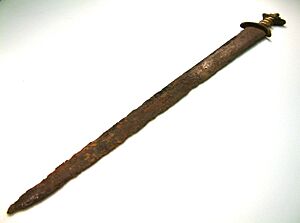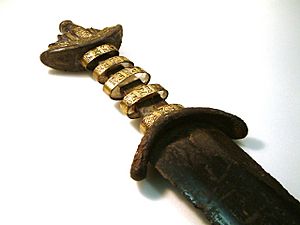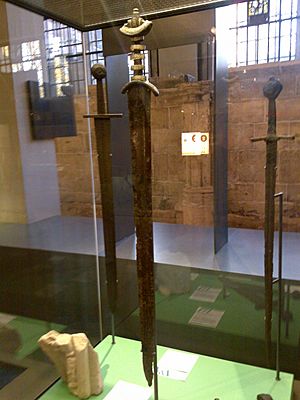Gilling sword facts for kids
Quick facts for kids Gilling sword |
|
|---|---|

The Gilling sword
|
|
| Created | late 9th to early 10th Century AD |
| Period/culture | Anglo-Saxon |
| Discovered | 1976 Gilling West, North Yorkshire |
| Present location | Medieval Gallery, Yorkshire Museum, York |
The Gilling sword is an amazing Anglo-Saxon sword. It was made a very long time ago, between the late 800s and early 900s AD. A schoolboy found it in a river in 1976. Today, you can see it at the Yorkshire Museum.
Contents
How the Gilling Sword Was Found
The Gilling sword was discovered on April 9, 1976. A nine-year-old boy named Gary Fridd found it. He was exploring by Gilling Beck, a small river in Gilling West, North Yorkshire.
A police officer later described where it was found. It was "33 feet east of a bridge and two feet from the water's edge." A big digging machine had been working nearby. This machine might have moved the sword, making it easier to find.
The sword was not officially declared "treasure." This meant it belonged to Gary, the boy who found it. Gary even appeared on the famous children's TV show Blue Peter. He talked about his amazing discovery. Both he and the sword received special Blue Peter badges! The Yorkshire Museum bought the sword in 1977.
What the Gilling Sword Looks Like
The Gilling sword is quite long, measuring about 83.8 centimeters (33 inches). Its widest part, near the handle, is about 8.6 centimeters (3.4 inches). The blade has two sharp edges, which is called "bifacial."
The handle, also known as the hilt, is very decorative. It has silver designs that mix shapes and patterns. You can also see patterns that look like flowers, leaves, and plants.
The blade itself is about 70 centimeters (27.5 inches) long. It gets narrower as it goes from the handle to the tip. There's a shallow groove along the blade called a "fuller." This groove helps make the sword lighter and stronger. You can also see faint patterns on the blade. These patterns show it was made using a special technique called "pattern-welding."
Why the Gilling Sword is Important
The Gilling sword is a great example of a late Anglo-Saxon sword. Experts classify it as a 'type L' sword. This type was common during the Viking period in England. It's similar to another sword found in Fiskerton, Lincolnshire.
The sword might have originally been buried in a grave. The digging machine mentioned earlier could have disturbed this grave. This would explain why the sword was found in the river.
Where You Can See the Gilling Sword
The Gilling sword is part of the collection at the Yorkshire Museum. It has been shown in many important exhibitions.
In 1982, it was a star in "The Vikings in England" exhibition. This show was opened by the Prince of Wales (who is now King Charles III). Over 235,000 people visited the exhibition. It even won a special award for its presentation and educational projects.
When the Yorkshire Museum closed for repairs in 2010, the Gilling sword traveled. It was displayed at the British Museum in London. It returned to the Yorkshire Museum when it reopened later that year.
Since 2013, the sword has been a key part of the permanent medieval exhibition at the Yorkshire Museum. This exhibition is called "Capital of the North."
From 2017, the sword was part of a traveling exhibition. This show was called 'Viking: Rediscover the Legend'. It traveled with other famous Viking treasures, like the Vale of York Hoard and the Cuerdale Hoard. The tour started at the Yorkshire Museum. It then visited places like the Atkinson Art Gallery and Library and Norwich Castle Museum.
The Gilling sword returned to the Yorkshire Museum in September 2019. You can still see this amazing piece of history there today!



